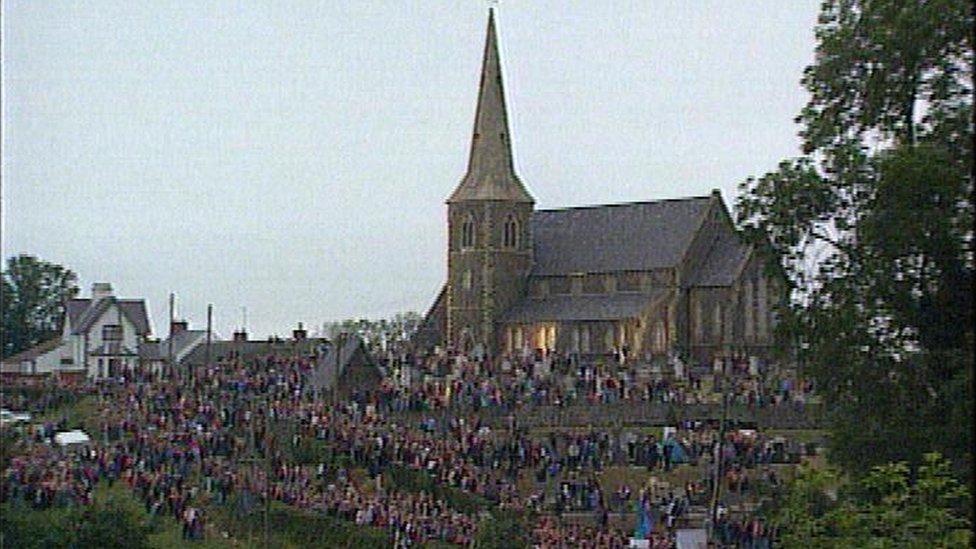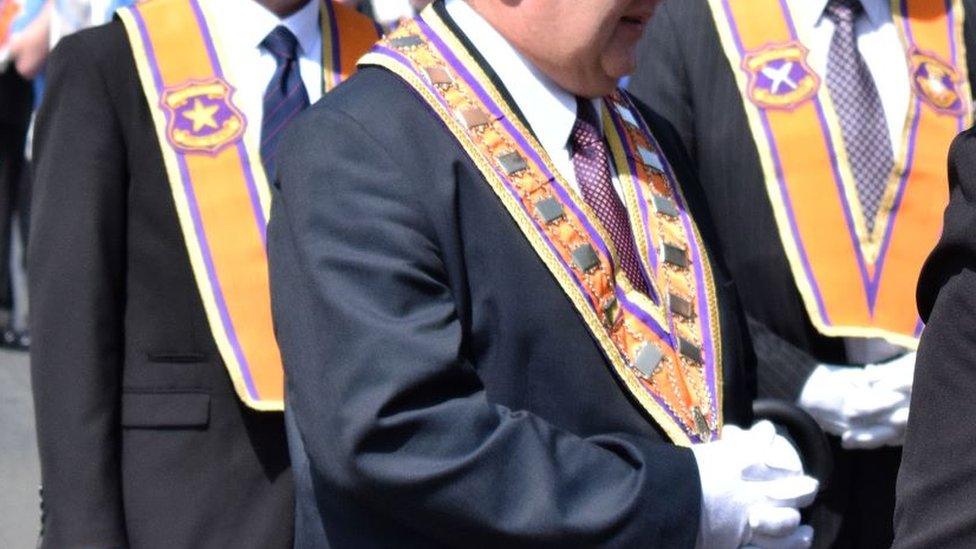NI state papers highlight sectarian tensions in 1997
- Published

Violence erupted in 1996 between the police and thousands of loyalists at Drumcree Parish Church
Difficulties facing the incoming Labour Government of Tony Blair on the issue of contentious parades feature in previously confidential government files just published.
On 29 April, 1997, a senior NI Office official produced a file for the new Labour NI secretary, Dr Mo Mowlam.
Stephen Leach noted that Labour was committed to establishing a parades commission to adjudicate on marches.
But he said it would have "high political voltage on both sides".
The file is among more than 600 released by the Public Record Office in Belfast which are mostly from 1997, but some have an earlier cover date.
Mr Leach said that a parades commission would significantly impact on the prospects for local accommodations on a number of contentious parades in the summer months as well as the Government's primary duty of preserving life and maintaining law and order.
In 1996, the RUC initially re-routed the Drumcree parade from Portadown's Garvaghy Road, leading to violent clashes. The decision was then reversed, generating major disturbances in nationalist areas.
In his memo, titled Parades: The Way Ahead, the NIO official stated that "most unionists regard the parades issue as encapsulating their wider fears of a continuing shift of political advantage towards nationalism and even many moderates [uninvolved in the Marching Orders] saw Drumcree, 1996 as a 'line in the sand' necessary to protect their identity and culture from progressive erosion".
He said that the prospect of further constraints on parades aroused an "atavistic response from the unionist community" which recognised that it had "lost dominance in NI".

Mr Leach said that "to many nationalists, the handling of the parades issue is an acid test of [the British Government's] resolve to create in NI a just and equitable society".
He said that opposition to Orange Order parades "derives from genuine popular resentment, existing for decades, which was fanned into greater anger by Drumcree 1996" but many nationalists "would favour some degree of local flexibility and would oppose having their legitimate concerns hijacked by Sinn Féin".
Sectarian boycotts concern
Sectarian boycotts of businesses in the wake of Drumcree in the summer of 1996 were highlighted in a letter to the NI Secretary, Sir Patrick Mayhew from the chairman of the NI Forum.
Sir Patrick said that any discrimination was "wholly unjust".
Pomeroy, County Tyrone, was among the areas worst affected and a group of Protestant traders in Cookstown contacted the NIO on 16 September, 1996, seeking a meeting about a boycott of traders.
Their spokesman, Cllr Trevor Wilson, said: "The boycott and associated criminal activity had placed the traders' backs to the wall."
Presbyterian Moderator, the Rev Harry Allen, raised the issue in an address in Dublin.
He said: "The spirit of boycott has been excused as punishing those who manned barricades during the Drumcree stand-off but the fact is that, in small towns where Protestants are a minority, sinister forces are creating conditions where every Protestant business is being targeted.
"This had led to the counter-threat of the boycotting of RC (Roman Catholic) businesses."
The boycott issue was the subject of a memo from the NIO Security Policy and Operations Division to ministers and officials, dated 30 September, 1996.

Police fire plastic bullets at Drumcree in July 1996
In his assessment, the author, Tom Clarke observed that, while there was plenty of evidence of a boycott campaign, it was difficult to locate concrete evidence that Sinn Féin and the Provisional IRA were playing a coordinating role.
In his view, Sinn Féin's public position was that the boycott was "justified against those who took part in the events surrounding Drumcree" but should not be applied indiscriminately against Protestants.
Mr Clarke also told officials that the boycott was being deeply felt in Pomeroy and Armagh, and continued in Enniskillen, Rosslea, Newtownbutler and Lisnaskea, in County Fermanagh, though there were "signs that it is receding".
He added: "Politically, it is reported that Sinn Féin feel they are benefiting from the boycott campaign. Many Nationalists are angry about Drumcree and see the boycott of businesses owned by those identified with the Orange Order as legitimate."
How 1969 sparked the Provisional IRA's deadly campaign
But, at the same time, the file notes that there was some evidence that the allegations of a mounting boycott were exaggerated.
Harryville
The weekly picket of a Catholic church in Ballymena, County Antrim, by loyalists protesting at the re-routing of Orange parades in the area is also covered in the files.
An NIO memo from September 1997 records that the blockade of Our Lady of Mercy Catholic Church in Harryville began in the autumn of 1996 in apparent response to nationalist obstruction of Orange parades in Dunloy.
The protests at Harryville continued and, in May 1997, loyalist protesters again clashed with the RUC and in June some loyalists broke into the church and attempted to set it on fire.
The picket was finally called off in May 1999.
Concern at Wright prison transfer

Billy Wright founded the Loyalist Volunteer Force (LVF)
The transfer of the Portadown-based LVF (Loyalist Volunteer Force) and former UVF leader, Billy Wright, from segregated accommodation at Maghaberry Prison to the nearby Maze Prison "for his own safety" also features in the papers.
At a meeting of the Anglo-Irish Secretariat on 17 April, 1997, the Irish joint secretary, David Donoghue voiced concerns about Wright's motives being sinister and the move's implications for the loyalist ceasefire.
Peter Bell of the NIO said that the decision of the NI prison agency to transfer Wright to the Maze, which was designed to house high-risk prisoners, was made on pragmatic grounds and for the maintenance of order within the prison system.
He added that the secretary of state would be consulted.
On 27 December, 1997, just eight months later, Wright was shot dead by INLA prisoners whose compound adjoined his cell in the Maze.
Related topics
- Published30 December 2019
